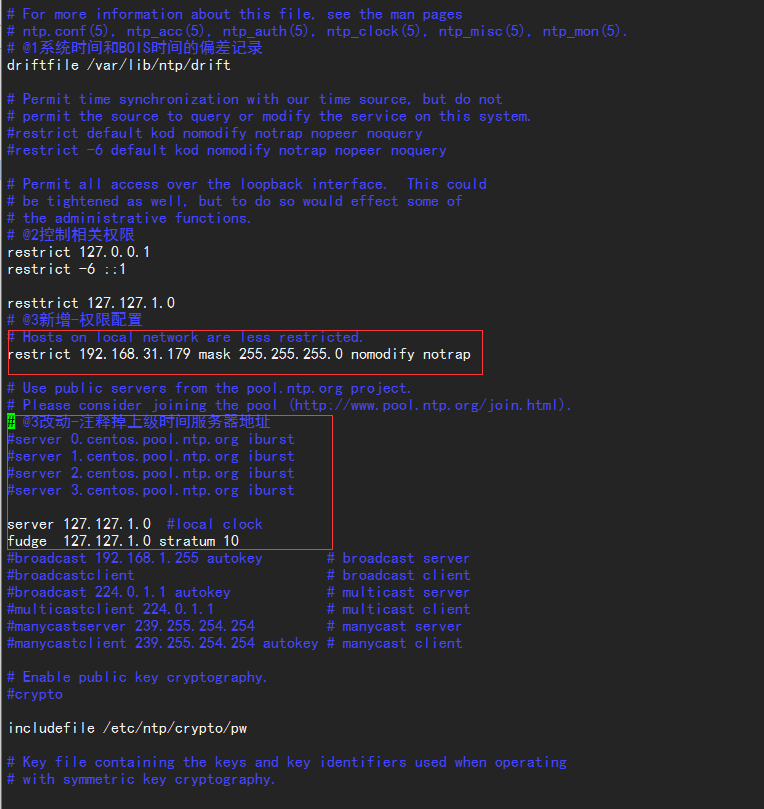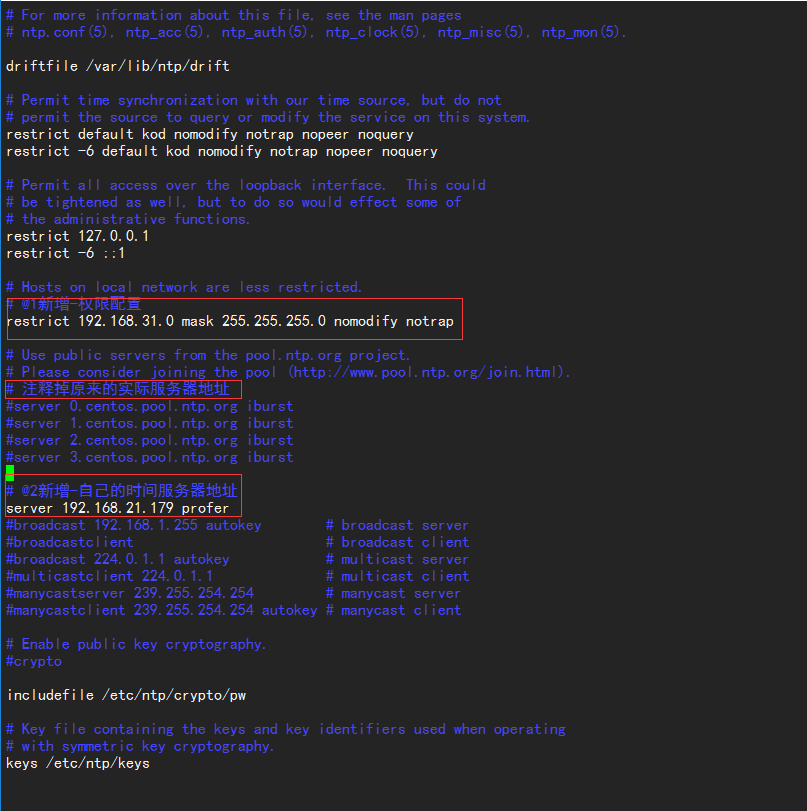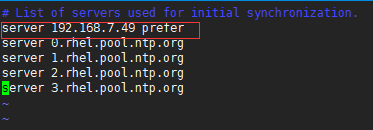一:NTP是网络时间同步协议,就是用来同步网络中各个计算机的时间的协议。
二:NTP服务端配置
1.检查系统是否安装了NTP包(linux系统一般自带NTP4.2),没有安装我们直接使用yum命令在线安装: yum install ntp
2.NTP服务端配置文件编辑: vim /etc/ntp.conf
结果:

# @3新增-权限配置restrict 127.127.1.0restrict 192.168.31.0 mask 255.255.255.0 nomodify notrap# @3改动-注释掉上级时间服务器地址#server 0.centos.pool.ntp.org iburst#server 1.centos.pool.ntp.org iburst#server 2.centos.pool.ntp.org iburst#server 3.centos.pool.ntp.org iburst# @4新增-上级时间服务器server 127.127.1.0 # local clockfudge 127.127.1.0 stratum 10
2.启动NTP时间服务器:service ntpd start
3.设置NTP开机自动启动:chkconfig ntpd on
4.查看NTP是否正常运行:netstat -tlunp | grep ntp
5.配置防火墙过滤规则:/sbin/iptables -I INPUT -p udp --dport 123 -j ACCEPT
如何配置:/etc/sysconfig/iptables 文件内配置开放udp 123端口: -A INPUT -p udp --destination-port 123 -j ACCEPT
A.服务端配置文件解释
①1:设定NTP主机来源(其中prefer表示优先主机),192.168.31.134是本地的NTP服务器,所以优先指定从该主机同步时间。
server 192.168.7.49 prefer
server 0.rhel.pool.ntp.org
server 1.rhel.pool.ntp.org
server 2.rhel.pool.ntp.org
server 3.rhel.pool.ntp.org
②2:限制你允许的这些服务器的访问类型,在这个例子中的服务器是不容许修改运行时配置或查询您的Linux NTP服务器
restrict 192.168.0.0 mask 255.255.255.0 notrust nomodify notrap
在上例中,掩码地址扩展为255,因此从192.168.0.1-192.168.0.254的服务器都可以使用我们的NTP服务器来同步时间
#此时表示限制向从192.168.0.1-192.168.0.254这些IP段的服务器提供NTP服务。
restrict 192.168.0.0 mask 255.255.255.0 notrust nomodify notrap noquery
#设置默认策略为允许任何主机进行时间同步
restrict default ignore
二:NTP客户端配置
1.检查安装NTP服务有没有安装,未安装请自行安装
2.NTP客户端配置文件编辑: vim /etc/ntp.conf

# @1新增-权限配置restrict 192.168.31.0 mask 255.255.255.0 nomodify notrap# Use public servers from the pool.ntp.org project.# Please consider joining the pool (http://www.pool.ntp.org/join.html).# 注释掉原来的实际服务器地址#server 0.centos.pool.ntp.org iburst#server 1.centos.pool.ntp.org iburst#server 2.centos.pool.ntp.org iburst#server 3.centos.pool.ntp.org iburst# @2新增-自己的时间服务器地址server 192.168.31.223 prefer <==以這部主機為最優先#broadcast 192.168.1.255 autokey # broadcast server#broadcastclient # broadcast client#broadcast 224.0.1.1 autokey # multicast server#multicastclient 224.0.1.1 # multicast client#manycastserver 239.255.254.254 # manycast server#manycastclient 239.255.254.254 autokey # manycast client
3.手动同步一次时间:/usr/sbin/ntpdate192.168.31.134 (服务端主机IP,这里需要先关闭NTP服务哦)
4.启动NTP服务:service ntpd start
5.观察时间同步状况:ntpq -p
结果:
[root@localhost hct]# ntpq -p remote refid st t when poll reach delay offset jitter==============================================================================*192.168.31.134 LOCAL(0) 11 u 64 128 377 0.202 73.980 412.834
⑥查看时间同步结果:ntpstat
[root@hct ~]# ntpstat
unsynchronised
polling server every 8 s
同步失败,同步也需要时间嘛,需等待5-10分钟再次查询:
Every 2.0s: ntpstat Tue Jul 11 16:55:57 2017synchronised to NTP server (10.10.11.247) at stratum 12 time correct to within 605 ms polling server every 128 s
OK!时间同步完成,date一下是不是和服务器主机时间一致呢
B.客户端配置文件详解
修改/etc/ntp/stpe-tickers文件,内容如下(当ntpd服务启动时,会自动与该文件中记录的上层NTP服务进行时间校对

C.系统时间与硬件时间同步
如果主从服务时间超过1000秒则不再进行同步了,这时候要手动同步,即:/usr/sbin/ntpdate命令,如果怕服务器时差会经常变动比较大可以再Linux中添加计划任务,例如:
10 5 * * * root /usr/sbin/ntpdate 192.168.31.223 && /sbin/hwclock -w
ntp服务,默认只会同步系统时间。如果想要让ntp同时同步硬件时间,可以设置/etc/sysconfig/ntpd文件,在/etc/sysconfig/ntpd文件中,添加 SYNC_HWCLOCK=yes 这样,就可以让硬件时间与系统时间一起同步。
D:ntpq -p各个选项相关信息
restrict 控制相关权限。
语法为: restrict IP地址 mask 子网掩码 参数
其中IP地址也可以是default ,default 就是指所有的IP
参数有以下几个:
ignore :关闭所有的 NTP 联机服务
nomodify:客户端不能更改服务端的时间参数,但是客户端可以通过服务端进行网络校时。
notrust :客户端除非通过认证,否则该客户端来源将被视为不信任子网
noquery :不提供客户端的时间查询:用户端不能使用ntpq,ntpc等命令来查询ntp服务器
notrap :不提供trap远端登陆:拒绝为匹配的主机提供模式 6 控制消息陷阱服务。陷阱服务是 ntpdq 控制消息协议的子系统,用于远程事件日志记录程序。
nopeer :用于阻止主机尝试与服务器对等,并允许欺诈性服务器控制时钟
kod : 访问违规时发送 KoD 包。
restrict -6 表示IPV6地址的权限设置。
root@www ~]# vim /etc/ntp.conf# 1. 先處理權限方面的問題,包括放行上層伺服器以及開放區網用戶來源:restrict default kod nomodify notrap nopeer noquery <==拒絕 IPv4 的用戶restrict -6 default kod nomodify notrap nopeer noquery <==拒絕 IPv6 的用戶restrict 220.130.158.71 <==放行 tock.stdtime.gov.tw 進入本 NTP 伺服器restrict 59.124.196.83 <==放行 tick.stdtime.gov.tw 進入本 NTP 伺服器restrict 59.124.196.84 <==放行 time.stdtime.gov.tw 進入本 NTP 伺服器restrict 127.0.0.1 <==底下兩個是預設值,放行本機來源restrict -6 ::1restrict 192.168.100.0 mask 255.255.255.0 nomodify <==放行區網來源# 2. 設定主機來源,請先將原本的 [0|1|2].centos.pool.ntp.org 的設定註解掉:server 220.130.158.71 prefer <==以這部主機為最優先server 59.124.196.83server 59.124.196.84# 3.預設時間差異分析檔案與暫不用到的 keys 等,不需要更動它:driftfile /var/lib/ntp/driftkeys /etc/ntp/keys
ntpd、ntpdate的区别
下面是网上关于ntpd与ntpdate区别的相关资料。如下所示所示:
使用之前得弄清楚一个问题,ntpd与ntpdate在更新时间时有什么区别。ntpd不仅仅是时间同步服务器,它还可以做客户端与标准时间服务器进行同步时间,而且是平滑同步,并非ntpdate立即同步,在生产环境中慎用ntpdate,也正如此两者不可同时运行。
时钟的跃变,对于某些程序会导致很严重的问题。许多应用程序依赖连续的时钟——毕竟,这是一项常见的假定,即,取得的时间是线性的,一些操作,例如数据库事务,通常会地依赖这样的事实:时间不会往回跳跃。不幸的是,ntpdate调整时间的方式就是我们所说的”跃变“:在获得一个时间之后,ntpdate使用settimeofday(2)设置系统时间,这有几个非常明显的问题:
第一,这样做不安全。ntpdate的设置依赖于ntp服务器的安全性,攻击者可以利用一些软件设计上的缺陷,拿下ntp服务器并令与其同步的服务器执行某些消耗性的任务。由于ntpdate采用的方式是跳变,跟随它的服务器无法知道是否发生了异常(时间不一样的时候,唯一的办法是以服务器为准)。
第二,这样做不精确。一旦ntp服务器宕机,跟随它的服务器也就会无法同步时间。与此不同,ntpd不仅能够校准计算机的时间,而且能够校准计算机的时钟。
第三,这样做不够优雅。由于是跳变,而不是使时间变快或变慢,依赖时序的程序会出错(例如,如果ntpdate发现你的时间快了,则可能会经历两个相同的时刻,对某些应用而言,这是致命的)。因而,唯一一个可以令时间发生跳变的点,是计算机刚刚启动,但还没有启动很多服务的那个时候。其余的时候,理想的做法是使用ntpd来校准时钟,而不是调整计算机时钟上的时间。
NTPD 在和时间服务器的同步过程中,会把 BIOS 计时器的振荡频率偏差——或者说 Local Clock 的自然漂移(drift)——记录下来。这样即使网络有问题,本机仍然能维持一个相当精确的走时。
原创:
https://blog.csdn.net/willinge/article/details/79928726
友情链接: